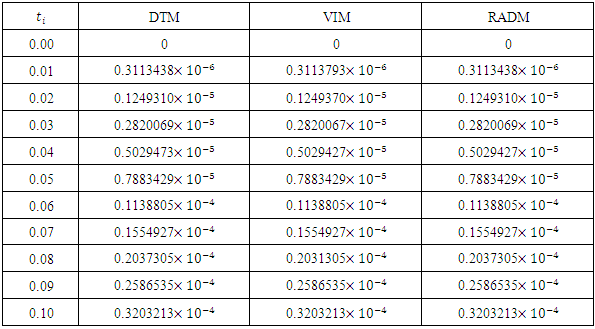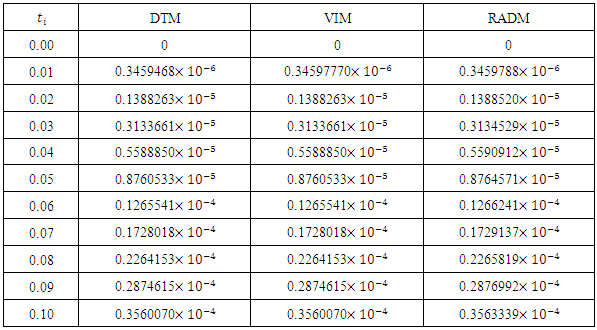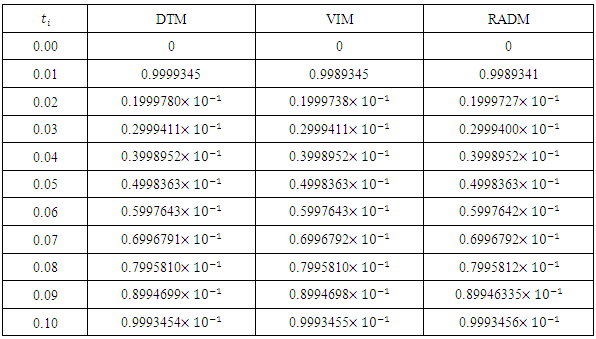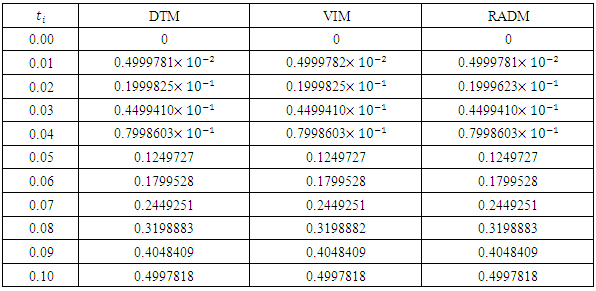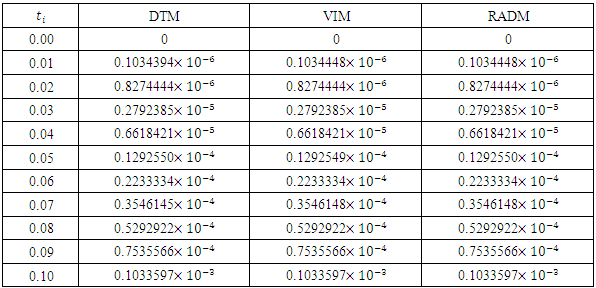-
Paper Information
- Next Paper
- Previous Paper
- Paper Submission
-
Journal Information
- About This Journal
- Editorial Board
- Current Issue
- Archive
- Author Guidelines
- Contact Us
Applied Mathematics
p-ISSN: 2163-1409 e-ISSN: 2163-1425
2016; 6(2): 25-35
doi:10.5923/j.am.20160602.02

Revised Adomian Decomposition Method for the Solution of Modelling the Polution of a System of Lakes
H. Ibrahim , I. G. Bassi , P. N. Habu
Department of Mathematics, Federal University Lafia, Lafia, Nigeria
Correspondence to: H. Ibrahim , Department of Mathematics, Federal University Lafia, Lafia, Nigeria.
| Email: |  |
Copyright © 2016 Scientific & Academic Publishing. All Rights Reserved.
This work is licensed under the Creative Commons Attribution International License (CC BY).
http://creativecommons.org/licenses/by/4.0/

Pollution has become a very serious threat to our surroundings. Monitoring pollution is a step forward toward planning to save the surrounding. The use of differential equations in monitoring pollution has become possible. This work presents the Revised Adomian decomposition method (RADM) to the model of pollution for a system of three lakes interconnected by channels. This method is based on Adomian polynomials. Three input models were solved to show that RADM can provide analytical solutions of pollution model in convergent series form. In addition, the Differential transform method (DTM), Variational iteration method (VIM) and Fehlberg fourth-fifth-order Runge-Kutta method with degree four interpolant (RK45F) of the numerical solution of the lakes system problem is used as a reference to compare with the semi-analytical approximations showing the high accuracy of the results. The main advantage of the proposed method is that it yields a series solution with accelerated convergence and does not generate secular terms.
Keywords: Revised Adomian decomposition method, Water pollution, Pollution of system of lakes, Adomian polynomials
Cite this paper: H. Ibrahim , I. G. Bassi , P. N. Habu , Revised Adomian Decomposition Method for the Solution of Modelling the Polution of a System of Lakes, Applied Mathematics, Vol. 6 No. 2, 2016, pp. 25-35. doi: 10.5923/j.am.20160602.02.
Article Outline
1. Introduction
- Numerous problems in physics, Biology and engineering are modeled by system of differential equations, which are solved by semi-analytical methods like Adomian decomposition method (ADM) [14-15], Homotopy pereturbation method (HPM) [17], New iterative method (NIM) [18], Differential transform method (DTM) [16], Revised new iterative method (RNIM) [19], Taylor collocation mehod (TCM) [21], Variational iteration method (VIM) [20], among others.Among the above mentioned methods, the RADM is very simple in its principles and applications to solve system of nonlinear differential equations as it does not generate secular terms or rely on trial functions or on a perturbation parameter as other does. Revised ADM [2] was proposed to solve system of ordinary/fractional differential equations. The revised method yields a series solution which converges faster than the series obtained by the standard ADM [14]. This tecnique’s approximation is based on the Adomian polynomial.Therefore, in this work, we present the application of the RADM to find approximations for a pollution model of lakes system [3-11]. The aim of the model is to describe the pollution of a system of lakes, considering three input models, i.e, periodic (Sinosoidal) input, exponential decaying (Impulse) input and the linear (Step) input as depicted in figure 1. The results obtained are compared with that of DTM, VIM and RK45F method.
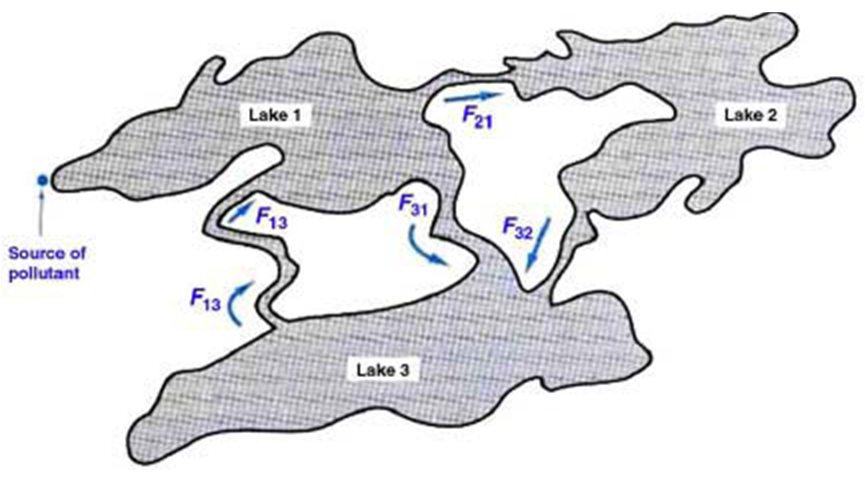 | Figure 1. System of three lakes with interconnecting channels. A pollutant enters the first lake at the indicated source. [23] |
2. Description of the Model of Pollution Problem
- A system of pollution of lakes is a set of lakes interconnected by channels. These lakes are modeled by large compartments interconnected by pipelines [1]. In figure 1, a system of three lakes;
 and
and  is shown. Arrows represent the direction of flow through each channel or pipeline [22]. When a pollutant enters the first lake, i.e
is shown. Arrows represent the direction of flow through each channel or pipeline [22]. When a pollutant enters the first lake, i.e  to know the rate of pollutant at which it enters the lake per unit time,
to know the rate of pollutant at which it enters the lake per unit time,  is introduced in the system in the system of equations. The function
is introduced in the system in the system of equations. The function  may be a constant or it may vary with time,
may be a constant or it may vary with time,  Let the amount of pollution in each lake be denoted by
Let the amount of pollution in each lake be denoted by  at any time
at any time  where
where  . It is being assumed that the amount of pollutant is equally distributed in each lake and the volume
. It is being assumed that the amount of pollutant is equally distributed in each lake and the volume  of each lake
of each lake  remains constant. Also, the type of pollutant remains constant and not transforming into other kinds of pollutant. The, the concentration of the lake is given by
remains constant. Also, the type of pollutant remains constant and not transforming into other kinds of pollutant. The, the concentration of the lake is given by | (1) |
 is considered to be free of pollution, i.e,
is considered to be free of pollution, i.e,  for
for  So the following conditions are obtained;
So the following conditions are obtained; Flux of pollutant flowing from lake
Flux of pollutant flowing from lake  to lake
to lake  at any time
at any time  measures the rate of flow of the concentration of pollutant and is given by
measures the rate of flow of the concentration of pollutant and is given by  | (2) |
 is constant from lake
is constant from lake  to lake
to lake  It can be easily seen that
It can be easily seen that  | (3) |
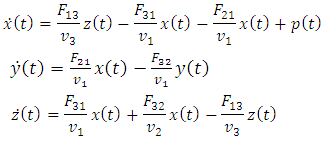 | (4) |
 | (5) |
 | (6) |
3. Revised ADM for a System of ODEs
- Consider the following system of ordinary differential equations [2];
 | (7) |
 and
and  are nonlinear continuous functions of its argument. Integrating both side of (7) from
are nonlinear continuous functions of its argument. Integrating both side of (7) from  to
to  and then, using the initial conditions, we get
and then, using the initial conditions, we get | (8) |
 In [2], a modification of the ADM was proposed. There define the following recurrence relation;
In [2], a modification of the ADM was proposed. There define the following recurrence relation; | (9) |
 is defined as
is defined as  | (10) |
 and
and  are A domain polynomials corresponding to
are A domain polynomials corresponding to  and
and  respectively.Taking
respectively.Taking  | (11) |
4. Numerical Simulation
- In this section, we apply the RADM described above to find approximate analytical solutions for the three inputs stated earlier to illustrate the effectiveness and accuracy of the method. To simulate the pollution in the lakes, we coded the RADM in Maple 13.
4.1. Periodic (Sinusoidal) Input Model
- The Sinusoidal input model is used for pollutants that are introduced to the lake periodically. As an illustration, we take
 where
where  is the average input concentration of pollutant,
is the average input concentration of pollutant,  is the amplitude of fluctuations, and
is the amplitude of fluctuations, and  is the frequency of fluctuations. Taking
is the frequency of fluctuations. Taking  and the parameter values given in (6), the system (4) becomes;
and the parameter values given in (6), the system (4) becomes; | (12) |
 | (13) |
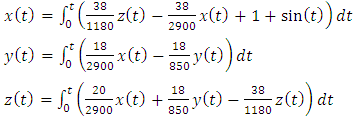 The revised Adomian procedure in (9) would lead to
The revised Adomian procedure in (9) would lead to The first iteration gives
The first iteration gives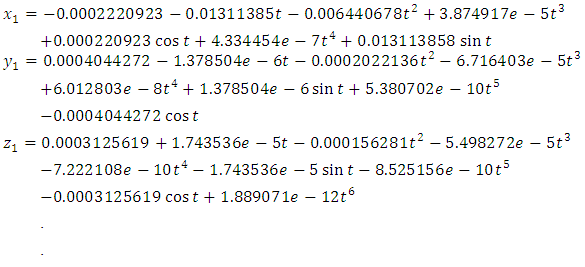 After the four iterations, we get
After the four iterations, we get
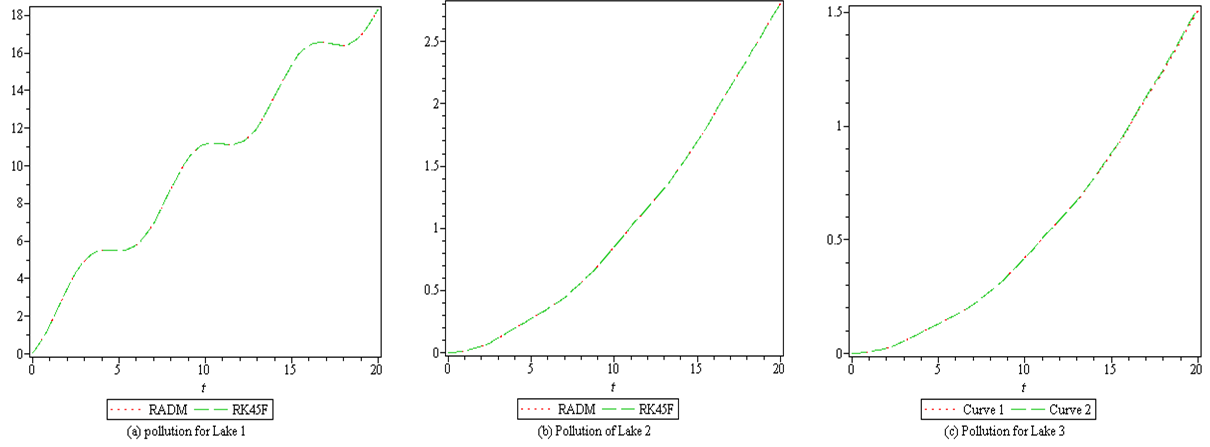 | Figure 2. Graphical representation of pollutant dumping periodically in Lake 1, 2 and 3 with RADM and RK45F solutions |
4.2. Linear (Impulse) Input Model
- This model describes the steady behavior of the pollutant addition into the lake. At the time zero, the pollutant concentration is also zero but as the time increases the addition of pollutant starts and remains steady afterwards. It can also be understood better by an example [3] that if a manufacturing plant starts production and dump it’s raw wastage on a constant rate, the
 In this case, Eqn.(9) becomes;
In this case, Eqn.(9) becomes;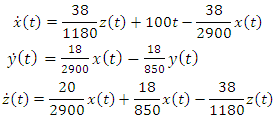 | (14) |
 | (15) |
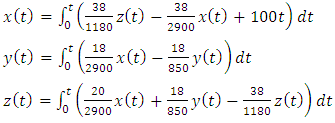 The revised Adomian scheme in (9) would lead to
The revised Adomian scheme in (9) would lead to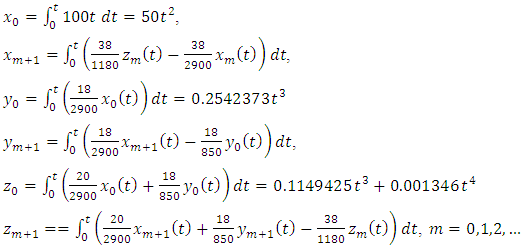 The first iteration is
The first iteration is And so on. After the third iteration, the sum of the first three iterations is;
And so on. After the third iteration, the sum of the first three iterations is;
 | Figure 3. Graphical representation of linear input pollutant in Lake 1, 2 and 3 with RADM and RK45F solutions |
4.3. Exponentially Decaying (Step) Input Model
- This model is assumed when heavy dumping of pollutant is under consideration, i.e,
 For instance, a industry situated in a city collects and store its wastage and dumps it after a few days period. So Eqn.(9) takes the form;
For instance, a industry situated in a city collects and store its wastage and dumps it after a few days period. So Eqn.(9) takes the form;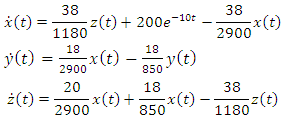 | (16) |
 | (17) |
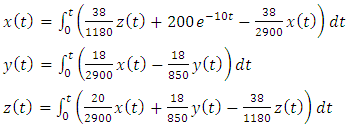 The revised Adomian procedure in (9) would lead to
The revised Adomian procedure in (9) would lead to The subsequent iteration is
The subsequent iteration is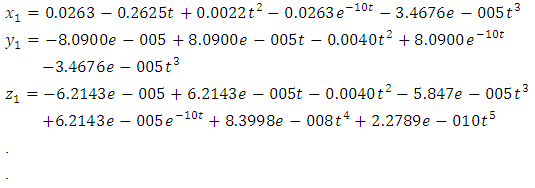 The sum of the first three iterations is;
The sum of the first three iterations is;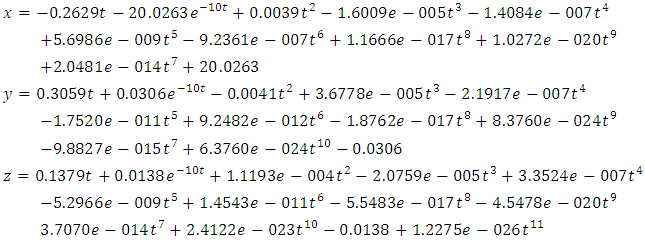
 | Figure 4. Graphical representation of exponentially decaying input pollutant in Lake 1, 2 and 3 with RADM and RK45F solutions. The time  is expressed in years is expressed in years |
5. Discussion
- In this paper, we presented the Revised A domain decomposition method (RADM) as a useful semi- analytical technique for solving a pollution model for a system of lakes. Three input models were successfully solved. For each of the three cases solved here, the RADM transformed the dynamic model into a system of Volterra integral equations for the coefficients of the series solutions.For the purpose of comparison, the Fehlberg fourth order Runge-Kutta method with degree four-fifth interpolant (RK45F) [12-13] built in Maple CAS software was used to obtain the exact of the model. Figure 1, 2 and 3 depicts the comparison among the exact solutions obtained by RK45F method and the RADM approximations for the three input models; sunoisodal, Impulse and step input. We also show in table 1-3, the comparison between the results obtained by the RADM and that of DTM [11] and VIM [7], the results are almost the same. The advantage of the RADM over the both method is that, it converges faster and does not generate secular terms like the VIM.Other semi-analytical methods like PIA, VIM, HPM and RVIM, among others require an initial approximation for the solutions sought and the computation of one or several adjustment parameters. If the initial approximation is properly chosen, the result obtained can be highly accurate. Nevertheless, no general methods are available to choose such initial approximation. This issue led to the use of Adomian polynomials [2] to solve such nonlinear problems.On the other hand, RADM just like DTM or LPDTM does not require any perturbation parameter or initial iteration for starting the iteration process. The solution procedure does not involve unnecessary computation and it converges faster to the exact solution of the pollution model. The approximation was made possible and easier using Maple 13.
6. Conclusions
- The problem of pollutions of three lakes with interconnecting channels has been considered. Different input models have been used for monitoring the pollution in three lakes. The Revised Adomian decomposition method has been used to solve the solution of the system of linear differential equations governing the problem. The results are compared with those obtained by VIM [7] and DTM [11]. This comparison shows that the results are almost the same, but the solution procedure does not generate secular (noise) terms as the case of VIM, and converges faster to the exact solutions obtained by RK45F method.
ACKNOWLEDGEMENTS
- The Authors are grateful to Dr. T. Aboiyar of the University of Agriculture, Makurdi. Nigeria for his useful comments which have improved the quality of this work. We also sincerely appreciates Jafar Biazar of the University of Guilan for the light we have received in some of his publications. Thank you.
Appendix
|
|
|
|
|
|
|
|
|
 Abstract
Abstract Reference
Reference Full-Text PDF
Full-Text PDF Full-text HTML
Full-text HTML
